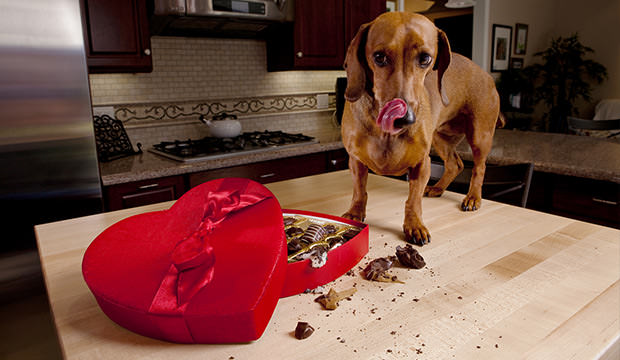
It is perfectly normal for a dog lover such as yourself to simply not be able to resist those begging puppy eyes that are constantly looking at you while you eat, and normally, every now and then, we all end up slipping our pooches a scrap of food or two under the table.
However, did you ever stop to think if any of those foods we enjoy are possibly harmful to your buddy?
It is definitely a scary thought, but many of the items you could be feeding your dog could result in him getting extremely sick, and some can even be fatal. So, before you slip your pooch another ‘forbidden fruit’ type of treat, keep in mind these 15 items you should never give to your dog.
1. Chocolate
The chemical in chocolate called Theobromine is a natural stimulant found in the cocoa bean and is pretty toxic to your little ball of fur.
The substance becomes toxic when it’s ingested in 100 to 150 kilograms of body weight, thus smaller dogs are at much higher risk of suffering from intoxication.
White chocolate is less risky than dark chocolate, however, even those lighter types of chocolate which are less rich in fat, can still cause serious issues.
Signs of chocolate poisoning include: panting, excessive thirst, diarrhea, vomiting, tremors, seizures, and hyperactivity. If you notice any of these in your pooch, it’s necessary to get him to the vet immediately.
2. Grapes & Raisins

Even in the smallest amounts grapes and raisins can be toxic and even fatal to your dog.
It is a common misconception that dogs should eat all fruits since they are supposed to be healthy, but actually some fruits are quite toxic for dogs.
No one knows exactly why grapes and raisins are so toxic for canines, but they can indeed poison your dog’s body. The signs usually include: vomiting, dehydration, loss of appetite, and weakness.
The most serious symptoms are lack of urination, sudden kidney failure and even death.
3. Avocados
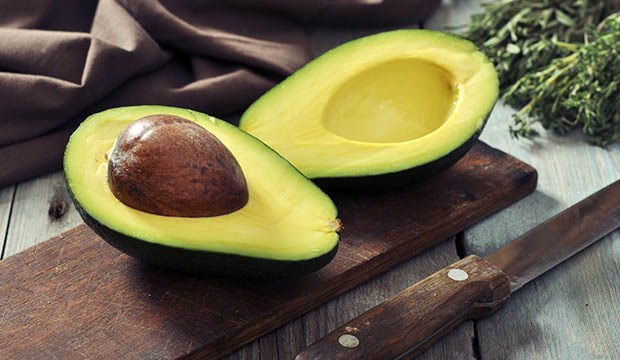
The substance called Persin in avocados is poisonous to dogs and the effects can range depending on the amount consumed and the size of the dog.
The symptoms may include vomiting and diarrhea, but they can get worse as the substance sets in over time.
Not all canines are allergic to Persin, and it typically requires eating a substantial amount of avocado in order for it to affect them severely, however, your pooch should definitely stay away from this treat, especially if your dog is small in size.
4. Onions

Thiosulphate in onions can cause hemolytic anemia, which basically means that the red blood cells in your dog’s system might start to burst.
Onions in any form or quantity are toxic to your pet, even in the smallest amounts.
Onion poisoning in dogs can also build up over time if your dog consistently ingests food containing onions. Small sized dogs are especially susceptible to this type of poisoning for it can only take a minimum of about 500 grams of onion to cause a severe health problem.
If your dog ends up ingesting large amounts of these veggies you might notice the following symptoms: vomiting, lethargy, fast heart rate, diarrhea, and breathlessness.
5. Moldy food & Mushrooms

But your pooch doesn’t forget that easily when it comes to food. Dogs will smell any ‘bonus treats’ and will find it in your garbage.
It is important to make sure your garbage isn’t accessible to your pet since he can develop Mycotoxicosis – poisoning as a result of eating mold.
This type of poisoning can also be the result of eating certain varieties of mushrooms, especially those you would find growing in your backyard.
If your dog ingested mushrooms or found some moldy food you threw away, the following symptoms might occur: vomiting, diarrhea, excessive salivation, weakness, stomach pain, lethargy, seizures, and in certain cases the result may even be fatal.
6. Salt

Whether your pooch got a hold of a salt shaker, drank too much sea water while out and about or you simply fed him some table scraps or snacks that are too salty.
In extreme moderation, salt is not necessarily a bad thing and it can actually be beneficial, but if your pooch ingested large amounts of salt he might soon develop some major health issues.
He will instantly become excessively thirsty and drink a substantial amount of water, which will subsequently cause them to urinate more often, and experience vomiting or diarrhea.
7. Dairy Products

Some canines will enjoy that delicious cheese or even ice cream without any adverse reaction, but others might end up vomiting, having diarrhea, severely upsetting the stomach and developing excessive gas.
Like with salt, your dog may also start drinking excessive amounts of water.
If you have a tendency to cook or bake something for your pooch, never use excessive amounts of dairy products or leave any of the ingredients unattended. Also, next time you’re buying food for your pet, make sure to read the nutrition label carefully since some pet foods contain cheese or other traces of dairy.
8. Chicken or Turkey Bones

The main issue is a potential choking hazard. Chicken and turkey bones are hollow and bone pieces can easily splinter off and get stuck in your dog’s mouth, throat and intestines.
Some dogs will simply gnaw on a bone without breaking any pieces off, but others will simply sink their teeth in it like there’s no tomorrow until it completely breaks apart.
However, chewing on something is beneficial for your pooch, especially after a meal, as it can help remove unwanted particles from his teeth.
So, rather than giving him a real bone and risk potential hazard, try giving him a toy bone to chew on. It can also be quite fun.
9. Garlic

Both vegetables are part of the Allium family, alongside leeks, chives, and shallots, but research shows that garlic is actually the most dangerous and most potent threat to dogs than other members of Allium family.
Garlic typically isn’t that toxic when ingested in very small doses, but if your pooch gets this ingredient continuously over time or in large doses, it can cause your pet to experience hemolytic anemia, aka bursting of red blood cells.
Beside hemolytic anemia, garlic could cause gastroenteritis, also known as inflammation of the intestines and stomach.
Symptoms of garlic poisoning might include vomiting, diarrhea, dehydration and excessive water drinking.
10. Yeast
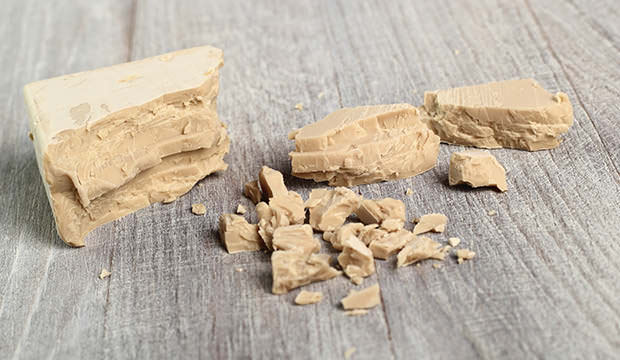
While most dogs won’t eat it even if they have the chance, some dogs might do it out of curiosity.
When ingested, raw yeast will expand in your pet’s stomach since the warm and wet surroundings provide more than ideal conditions for the yeast to do so.
This will cause the internal organs to react and expand, which might lead to cutting off blood flow, developing major breathing problems and cause bowel obstruction.
To make matters worse, raw yeast can cause alcohol poisoning in your dog as well. The yeast has the ability to ferment sugar, this sugar can then be rapidly absorbed into the blood stream, which produces carbon dioxide and alcohol poisoning.
Ultimately, your dog’s blood pressure and blood sugar levels will drop, resulting in various symptoms including drooling, vomiting, disorientation, diarrhea, bloating, weakness, and in severe cases, death.
11. Macadamia Nuts

Based on the research conducted by ASPCA, the typical dosage that can cause poisoning is 2 grams of nuts for every 2.2 pounds of your dog’s body weight, however, the sensitivity can vary from breed to breed.
To make matter worse, macadamia nuts are usually also covered in chocolate, which poses a double risk to dogs should they manage to get their paws on these treats.
The common poisoning signs include depression, tremors, fever, muscle weakness, and vomiting, and the symptoms typically appear within 12 hours from the moment of ingestion.
12. Alcohol

Foods that contain alcohol are also dangerous. Bread dough might lead to ethanol poisoning and eventually cause the dog to become intoxicated.
This is especially dangerous and can be effective immediately if your dog ingests alcohol on an empty stomach, since there is no food to absorb it.
Signs of alcohol poisonings in your dog might include seizures, low blood pressure, bloating, vomiting, diarrhea, lethargy, and inability to walk properly.
The symptoms will appear almost instantly after ingesting alcohol in his system, but they can take up to half an hour with larger dogs.
13. Peaches & Apricots
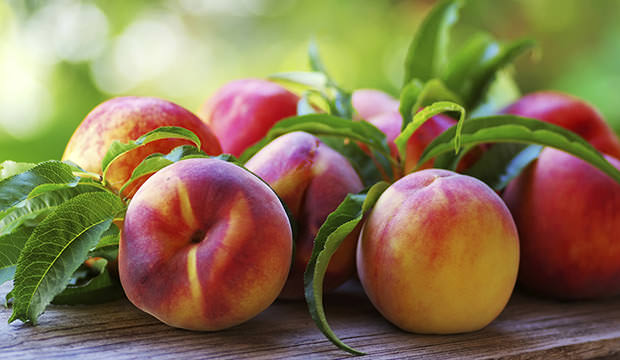
Now, you may be wondering ‘how can this delicious fruits be toxic for my pooch?’ Well, it is not so much the fruit itself but its sturdy, rough and possibly toxic pit.
Peach pit contains cyanide, which is deadly to your dog. Furthermore, the pit could get stuck in the dog’s throat or digestive tract and cause vomiting, diarrhea, dizziness, seizures and even death.
If your dog ends up eating a peach and ingesting its pit, you will immediately need to take him to the vet. Not only to treat his symptoms, but to make sure the pit isn’t stuck in his intestines.
14. Citrus Fruits

Lemon, for instance, contains the psoralen compounds and the aromatic oils which are poisonous to dogs, and if they end up in your pooch’s belly, he’ll most likely experience some unpleasant side effects including diarrhea, throwing up and even unusual light sensitivity.
Oranges and grapefruit are also a big no-no, and although dogs usually don’t like the sour taste of these fruits, it is paramount to keep him away from these as they contain the citric acid.
Citric acid can be found all over the plant, from the actual fruit and the seeds to the peelings, leaves and stems. If your pooch gets his paws on any of these, especially in large amounts, his central nervous system may be seriously damaged and you should take him to the vet immediately.
15. Gum
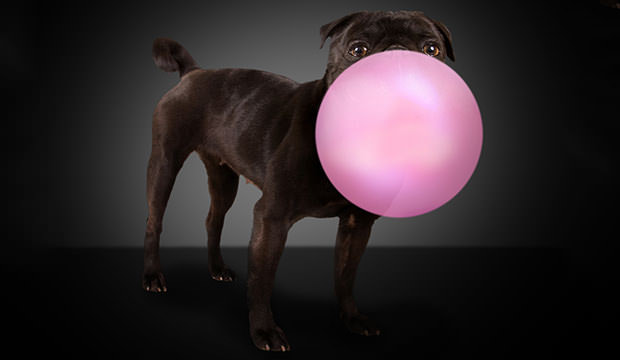
If your pooch ends up ingesting Xylitol, the symptoms may vary from vomiting and seizures to lethargy, and lack of coordination. Some pooches may also experience internal bleeding and deteriorated gums.
If ingested, Xylitol can also cause your dog’s pancreas to start releasing insulin, which can result in liver failure due to low blood sugar. All this happens quite rapidly, so if you notice any of these signs in your dog, take him to the vet immediately.
